De fotodetective (*1) – Hans Aarsman – Podium (2012) – ISBN: 9789057594533
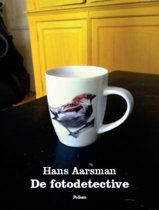 Waarom vinden we een foto mooi? Waarom fotograferen we het ene wel en het andere niet? Aan de hand van hilarische en ontluisterende voorbeelden toont Hans Aarsman hoe voorgebakken onze blik is en wat we over het hoofd dreigen te zien. In dit aanstekelijke boek doet hij verslag van zijn zoektocht naar nieuwe manieren van kijken en fotograferen. Als een detective ontdekt hij op foto’s kogelgaten, verdachte koffiemelk, verwijderde reclameborden en de man die schuilgaat achter de ‘Warum?’-borden.
Waarom vinden we een foto mooi? Waarom fotograferen we het ene wel en het andere niet? Aan de hand van hilarische en ontluisterende voorbeelden toont Hans Aarsman hoe voorgebakken onze blik is en wat we over het hoofd dreigen te zien. In dit aanstekelijke boek doet hij verslag van zijn zoektocht naar nieuwe manieren van kijken en fotograferen. Als een detective ontdekt hij op foto’s kogelgaten, verdachte koffiemelk, verwijderde reclameborden en de man die schuilgaat achter de ‘Warum?’-borden.
Hans Aarsman (1951) was een gevierd fotograaf toen hij besloot te stoppen met fotograferen. Tegenwoordig kijkt hij liever naar foto’s van anderen. In navolging van Sherlock Holmes doet hij dat met een speurende blik, onder meer in zijn wekelijkse rubriek ‘De Aarsman Collectie’ in de Volkskrant. Eerder verscheen van hem het boek Ik zie ik zie.
‘Aarsman ziet details die zonder zijn blik verborgen bleven, legt verbanden die anders niet worden gelegd, stelt onverwachte vragen en trekt bijzondere conclusies.’
Ronald Giphart
‘Ik heb de ziekte van Aarsman. Weg is het wilde kijken, onbekommerd om mij heen loeren.’
Nico Dijkshoorn
Tekst uit “Voor de zon is alles gelijk”: Fotografie is een tweedimensionaal medium. Toen het werd uitgevonden was het even zoeken hoe het moest worden beoordeeld. Zo waarheidsgetrouw leek het te zijn, zo letterlijk, dat was nog nooit vertoond. …
Wat jij niet ziet – Hans Aarsman – Podium (2014) – ISBN: 9789057596964
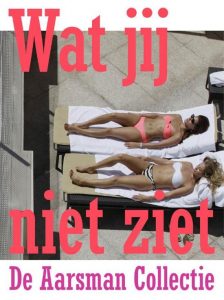
De Aarsman Collectie
Hoe poseer je het best voor een glamourfoto? Op welke manier slapen Chinezen? Hoe ziet het huis van een moordenaar eruit? Iedere dag struint Hans Aarsman (1951) duizenden nieuwsfoto’s af, op zoek naar een verhaal. Is het beeld authentiek of in scène gezet? Wat openbaart zich als je inzoomt op details?
Aarsman kiest voor de beelden die veel meer vertellen dan de foto’s op de voorpagina. Hij beschrijft met aanstekelijk enthousiasme wat je in eerste instantie over het hoofd dreigt te zien. Zijn rubriek “De Aarsman Collectie’ in de Volkskrant is onverminderd populair. Daarom is er nu een vervolg op het succesvolle Ik zie ik zie, met de titel… Wat jij niet ziet. Voor deze nieuwe bundel zijn de beste stukken uit de Volkskrant van de afgelopen vijf jaar geselecteerd.
Fotobesprekingen – Hans Aarsman – Passage (2011) – ISBN: 9789054522447

Hans Aarsman won in 2011 de Hendrik de Vriesprijs voor zijn gehele oeuvre. Dit boek is naar aanleiding daarvan verschenen.
Uit het juryrapport: Behalve met fotografie houdt Aarsman zich ook bezig met schrijven, en hij schrijft geweldig goed. In feite is zijn werk een effectieve vorm van cultuur- en kunstkritiek, gericht tegen de hype van de fotografie, en tegen consumentisme. Noties van originaliteit en signatuur zijn hem vreemd. Hij vindt wat hij zoekt op straat, en daarmee zet hij zijn publiek (kijkers én lezers) ertoe aan om minder doelgericht, maar met een meer onbevangen, avontuurlijke blik, naar de omringende wereld te kijken. En naar het werk van anderen: zo stelde hij tentoonstellingen samen die het volle licht op de talenten van ander fotografen moesten laten vallen.
Hans Aarsman (Amsterdam, 1951) is, net als Hendrik de Vries, een opmerkelijk dubbeltalent. Aarsman is bekend van onder meer zijn fotobesprekingen in de Volkskrant: De Aarsman Collectie. Daarnaast heeft hij meerdere uitgaven, columns en theaterstukken op zijn naam staan.
De foto’s in dit boek werden door Hans Aarsman besproken op www.photoq.nl
De Aarsman collectie (*) – Hans Aarsman – NAI (2005) – ISBN: 9789056624705
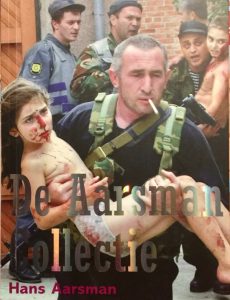 Een cursus kijken in zakformaat. Aarsman ziet op een foto altijd iets wat jij niet ziet. Het zijn vaak de meest onopvallende details waarachter een hele andere wereld schuilgaat. Telkens weer word je verrast door hoe je ogen je hebben bedrogen. Of zoals Aarsman zelf schrijft: ‘Er is niet één waarheid. Er zijn er minstens zeven.’
Een cursus kijken in zakformaat. Aarsman ziet op een foto altijd iets wat jij niet ziet. Het zijn vaak de meest onopvallende details waarachter een hele andere wereld schuilgaat. Telkens weer word je verrast door hoe je ogen je hebben bedrogen. Of zoals Aarsman zelf schrijft: ‘Er is niet één waarheid. Er zijn er minstens zeven.’
De Universal Photographer – Anne Greene en Arjan de Nooy – De Hef Publishers (2018) – ISBN: 9789069060521
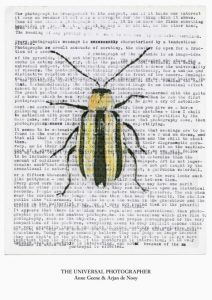 THE UNIVERSAL PHOTOGRAPHER
THE UNIVERSAL PHOTOGRAPHER
Met hun pseudowetenschappelijke werk laten Anne Geene (1983) en Arjan de Nooy (1965) het publiek op een nieuwe, vaak humorvolle manier naar de wereld kijken. Samen maakten ze eerder de publicatie Ornithology, een alternatieve vogelaarsbijbel bekroond met The Best Book Design from all over the World op de Buchmesse in Leipzig. Geene won dit jaar voor haar solowerk de Volkskrant Beeldende Kunst Prijs en tevens de publieksprijs.
The Universal Photographer gaat over de fictieve fotograaf “U’, die leefde van 1955 tot 2010. Aan de hand van het werk van “U’, dat verschillende stijlperiodes doorloopt en kunststromingen citeert, maakten Geene en De Nooy dit boek, dat enerzijds een “encyclopedie’ van de fotografie is en tevens het persoonlijke levensverhaal van een universele fotograaf.
De tentoonstelling The Universal Photographer is dit najaar voor het eerst te zien in Gemeentemuseum Den Haag van 13 oktober 2018 t/m 17 maart 2019. De bijbehorende publicatie verschijnt gelijktijdig met de tentoonstelling.
NRC-20181015 – The Universal Photographer – NRC-20181015 – The Universal Photographer
Concept en Visie in de fotografie, het geheim van succesvolle foto’s – Michael Freeman – Librero (2012) – ISBN: 9789089981868
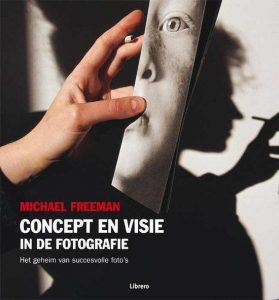 Michael Freeman geeft uitleg bij het werk van enkele van ’s werelds beste fotografen en vertelt hoe je naar hun foto’s kunt kijken, waardoor je meer begrip en appreciatie krijgt. Dit boek ligt in lijn met de voorgaande titels Compositie en Vormgeving en Concept en Analyse in de digitale fotografie, en is bestemd voor zowel amateur als professional, maar ook voor iedereen die gewoon van mooie foto’s houdt en ze beter wil begrijpen.
Michael Freeman geeft uitleg bij het werk van enkele van ’s werelds beste fotografen en vertelt hoe je naar hun foto’s kunt kijken, waardoor je meer begrip en appreciatie krijgt. Dit boek ligt in lijn met de voorgaande titels Compositie en Vormgeving en Concept en Analyse in de digitale fotografie, en is bestemd voor zowel amateur als professional, maar ook voor iedereen die gewoon van mooie foto’s houdt en ze beter wil begrijpen.
Wat is een goede foto?
… is deskundig gemaakt
… lokt een reactie uit
… biedt een gelaagde ervaring
… heeft een context binnen de fotografie
… bevat een idee
… imiteert niet
Bondsmeesterklasse Lustrumboek 2014 (*1 gedeeltelijk) – Fotobond (2014) – ISBN:
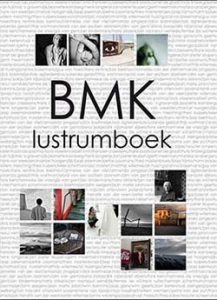 bmk boek 2014 voor mijn website 1_18_150_168 – bmk boek 2014 voor mijn website 1_18_150_168
bmk boek 2014 voor mijn website 1_18_150_168 – bmk boek 2014 voor mijn website 1_18_150_168
Ways of Seeing (*) – John Berger – British Broadcasting Corporation and Penquin Books (1972) – ISBN: 9780141035796
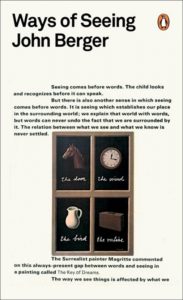 John Berger’s Ways of Seeing changed the way people think about painting and art criticism. This watershed work shows, through word and image, how what we see is always influenced by a whole hose of assumptions concerning that nature of beauty, truth, civilization, form, taste, class and gender. Exploring the layers of meaning within oil paintings, photographs and graphic art, Berger argues that when we see, we are not just looking – we are reading the language of images.
John Berger’s Ways of Seeing changed the way people think about painting and art criticism. This watershed work shows, through word and image, how what we see is always influenced by a whole hose of assumptions concerning that nature of beauty, truth, civilization, form, taste, class and gender. Exploring the layers of meaning within oil paintings, photographs and graphic art, Berger argues that when we see, we are not just looking – we are reading the language of images.
John Berger (Londen, 1926) verwierf faam met Ways of Seeing, de revolutionaire televisieserie over kunst die hij in de jaren zestig voor de BBC maakte. Het gelijknamige boek geldt nog altijd als een van de meest spraakmakende werken over kunstbeschouwing. In 1972 won Berger de James Tait Black Memorial Prize én de prestigieuze Booker Prize met zijn roman G. Tot zijn bekendste literaire werk behoren Vrucht van hun arbeid, een trilogie over het leven op het Franse platteland, en Ten huwelijk, een roman over aids. Berger geldt als een van de invloedrijkste Britse kunstenaars van de laatste vijftig jaar. De Spaanse regisseur Isabel Coixet wier film Elegy, naar de roman The Dying Animal van Philip Roth, dit najaar in Nederland in première gaat – zal Van A tot X verfilmen.
Quotes uit het boek:
“Colour photography is to the spectator-buyer what oil paint was to the spectator-owner.” [Page 140].
“The spectator-buyer stands in a very different relation to the world from the spectator-owner” [Page 141]
Onderscheid:
Spectator-owner: Bezit, echte leven. “You are what you have.”
Spectator-buyer: Aspiratie, geambieerd leven.
About Looking – John Berger – Bloomsbury (2009) – ISBN: 9780747599579
LET OP! Wellicht twee keer (2x) vermeld (Ook op 2 van 5)
 As a novelist, art critic, and cultural historian, Booker Prize-winning author John Berger is a writer of dazzling eloquence and arresting insight whose work amounts to a subtle, powerful critique of the canons of our civilization. In About Looking he explores our role as observers to reveal new layers of meaning in what we see. How do the animals we look at in zoos remind us of a relationship between man and beast all but lost in the twentieth century? What is it about looking at war photographs that doubles their already potent violence? How do the nudes of Rodin betray the threats to his authority and potency posed by clay and flesh? And how does solitude inform the art of Giacometti? In asking these and other questions, Berger quietly — but fundamentally — alters the vision of anyone who reads his work.
As a novelist, art critic, and cultural historian, Booker Prize-winning author John Berger is a writer of dazzling eloquence and arresting insight whose work amounts to a subtle, powerful critique of the canons of our civilization. In About Looking he explores our role as observers to reveal new layers of meaning in what we see. How do the animals we look at in zoos remind us of a relationship between man and beast all but lost in the twentieth century? What is it about looking at war photographs that doubles their already potent violence? How do the nudes of Rodin betray the threats to his authority and potency posed by clay and flesh? And how does solitude inform the art of Giacometti? In asking these and other questions, Berger quietly — but fundamentally — alters the vision of anyone who reads his work.
Landschapswaarnemingen (*) – Ger Dekkers – Waanders (2004) – ISBN: 9789040089763
 Geen mensen, geen bebouwing, geen voertuigen. Hooguit een dijk of een weg of een rij bomen. Door mensenhand geschapen landschappen, lijnrecht en grootschalig. En door Ger Dekkers gezien en volgens een vooropgezet plan gefotografeerd.
Geen mensen, geen bebouwing, geen voertuigen. Hooguit een dijk of een weg of een rij bomen. Door mensenhand geschapen landschappen, lijnrecht en grootschalig. En door Ger Dekkers gezien en volgens een vooropgezet plan gefotografeerd.
Ger Dekkers. Werkt inmiddels gedurende een halve eeuw als fotograaf in een geheel eigen en zonder meer unieke stijl. Dekkers heeft dan ook een indrukwekkend oeuvre. Dit boek vormt een retrospectief in woord en vooral in beeld van het werk van deze beeldende kunstenaar
Horizons Unlimited – Ger Dekkers – Van Spijk Art Projects (2000) – ISBN: 9789062165865
Recent besloot de kunstcommissie om waar mogelijk, waar zinvol iedere expositie te laten vergezellen van een uitgave. In samenwerking met Van Spijk Art Projects is het idee ontwikkeld om een nieuwe reeks kunstboeken uit te geven, waarbinnen de Gasunieuitgaven passen. Met deze Kwadrant-Art reeks wordt gepoogd om naast de bestaande kunstliefhebbers een nieuw, jong publiek te bereiken. De uitgave Horizons Unlimited gewijd aan het werk van de kunstenaar Ger Dekkers is de eerste in de nieuwe reeks.
Rusty brown – Chris Ware – Vintage Publishing (2019) – ISBN: 9780224078139
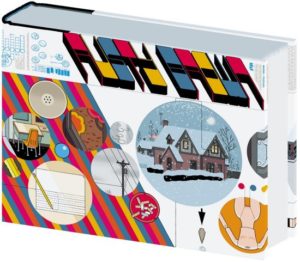
The week after I finished the last page of Jimmy Corrigan I immediately started a new long story based on characters who had originated as parodies, but whom now I wanted to humanize… amidst a setting of memories of my Omaha childhood and Nebraska upbringing.’ (Chris Ware, Monograph) Now, twenty years later, Ware is publishing Rusty Brown in book form. It is, he says, a fully interactive, full-colour articulation of the time-space interrelationships of six complete consciousnesses on a single Midwestern American day and the tiny piece of human grit about which they involuntarily orbit.’ The six characters are Rusty Brown himself, a shy schoolkid obsessed with superheroes, his father Woody’ Brown, an eccentric teacher at Rusty’s school, Chalky White, another schoolboy, Alison White, Chalky’s sister, Jason Lint, an older boy who bullies Rusty and Chalky and fancies Alison, and the boys’ teacher, Joanne Cole. Ware tells each of their stories in minute detail (or as he puts it, From childhood to old age, no frozen plotline is left unthawed’), producing another masterwork of the comics form that is at once achingly beautiful, heartbreakingly sad and painfully funny.
“Franklin Christenson “”Chris”” Ware (born December 28, 1967), is an American cartoonist known for his Acme Novelty Library series (begun 1994) and the graphic novels Jimmy Corrigan, the Smartest Kid on Earth (2000) and Building Stories (2012). His works explore themes of social isolation, emotional torment and depression. He tends to use a vivid color palette and realistic, meticulous detail. His lettering and images are often elaborate and sometimes evoke the ragtime era or another early 20th-century American design style.
Andere publicaties:
Building stories (2012) ISBN: 9780224078122
In Chris Ware’s own words, ‘Building Stories follows the inhabitants of a three-flat Chicago apartment house: a thirty-year-old woman who has yet to find someone with whom to spend the rest of her life; a couple who wonder if they can bear each other’s company for another minute; and finally an elderly woman who never married and is the building’s landlady…’ The scope, the ambition, the artistry and emotional heft of this project are beyond anything even Chris Ware has achieved before.
Monograph (2017) ISBN: 9780847860883
The first and much-anticipated monograph by multi-award winning cartoonist and graphic novelist Chris Ware, chronicling his influential quarter-century career.
nrc-handelsblad-20191205
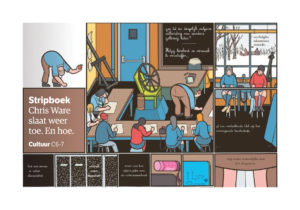
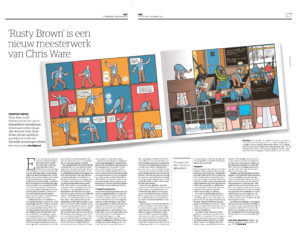
nrc-handelsblad-20191205-4197307 – Graphic novel – Chris Ware – nrc-handelsblad-20191205-4197307 – Graphic novel – Chris Ware
Jimmy Corrigan – The Smartest Kid on Earth – Chris Ware – Vintage Publishing (2001) – ISBN: 9780224062107

Jimmy Corrigan has rightly been hailed as the greatest graphic novel ever to be published. It won the Guardian First Book Award 2001, the first graphic novel to win a major British literary prize. It is the tragic autobiography of an office dogsbody in Chicago who one day meets the father who abandoned him as a child. With a subtle, complex and moving story and the drawings that are as simple and original as they are strikingly beautiful, Jimmy Corrigan is a book unlike any other and certainly not to be missed.
World Atlas of Street Photography – Jackie Higgens – Thames & Hudson (2014) – ISBN: 9780500544365
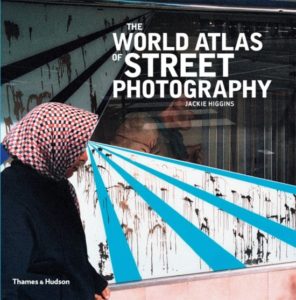 The World Atlas of Street Photography focuses on the abundance of photography that has been created on street corners around the globe; it includes classic documentary street photography, as well as images of urban landscapes, staged performances, and sculptures. In so doing, this compelling reference book locates the meeting point between street photography and atlas, between artists and their personal understanding of our environment, not via a cartographic bird’s-eye view but through a more intimate, human- centred perspective. From New York to New Delhi, Beijing to Brighton, Havana to Hamburg, and Sydney to Seoul, this magnificently illustrated book presents an international cast of more than one hundred established and emerging contemporary photographers.
The World Atlas of Street Photography focuses on the abundance of photography that has been created on street corners around the globe; it includes classic documentary street photography, as well as images of urban landscapes, staged performances, and sculptures. In so doing, this compelling reference book locates the meeting point between street photography and atlas, between artists and their personal understanding of our environment, not via a cartographic bird’s-eye view but through a more intimate, human- centred perspective. From New York to New Delhi, Beijing to Brighton, Havana to Hamburg, and Sydney to Seoul, this magnificently illustrated book presents an international cast of more than one hundred established and emerging contemporary photographers.
Recensie:
‘This dizzying global tour is a beautiful revelation, one that reveals street photography to be a global language … a fantastic examination of a genre that can too often be dismissed as a snapshot pastime … the most definitive guide to street photography we’ve seen so far’ – Amateur Photographer ‘A wonderful reference for anyone interested in capturing the street and its people in an imaginative way’ – Black & White Photography ‘This book is as useful as it is beautiful, featuring as it does the work of 100 photographers working in 50 different cities around the world and – most importantly – describing their approach’ – Advanced Photographer.
Street Photographers Manual – How to capture urban moments on phone, camera or SLR – David Gibson – Thames & Hudson Ltd (2014) – ISBN: 9780500291306
Whether dark, edgy or humorous, street photography shows us that daily life can be a little surreal but also gently poignant. Photo sharing on Flickr and Facebook has rejuvenated the genre, and its spirit has been reborn. This book is about the possibilities of street photography, and how it can be approached in a tangible way. It begins with an overview of street photography, examining its past, present and future, and looking at how the genre has changed over time. The reader is then introduced to twenty of the most acclaimed international street photographers, among them Bruce Gilden, Alex Webb, Nils Jorgensen and Saul Leiter. Integrated within the profiles are twenty fully illustrated tutorials, including how to shoot a face in a crowd and how to train your eye to observe and capture the unexpected. This book shows you that being a street photographer is about looking for the luck. But luck requires inspiration – and that is where this book is indispensable.
Weaving the Web (*) – Tim Berners-Lee – HarperCollins Publishers Inc. (2000) – ISBN: 9780062515872
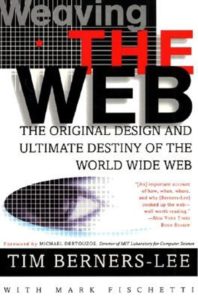 One of the most important figures in the creation of the World Wide Web describes its origins; its impact on the world and history; his view on such issues as censorship, privacy, and business; and his predictions for the future.
One of the most important figures in the creation of the World Wide Web describes its origins; its impact on the world and history; his view on such issues as censorship, privacy, and business; and his predictions for the future.
Timothy John (Tim) Berners-Lee (Londen, 8 juni 1955) is samen met zijn toenmalig manager, de Belg Robert Cailliau, de bedenker en grondlegger van het world wide web of wereldwijde web (www). Hieraan werkte hij toen hij consultant-software-engineer bij het CERN in Zwitserland was, van juni tot en met december 1990. Als directeur van het World Wide Web Consortium (W3C) houdt hij toezicht op de ontwikkeling van webtalen en -protocollen als HTML, XML, CSS en HTTP.
Timeline:
1980 – Software consultant at CERN.
1984 – Fellowship programme at CERN.
1989 – Information Management: A Proposal, Tim Berners-Lee, CERN March 1989, May 1990 (“A common base for communication while allowing each system to maintain its individuality”).
1990 – WorldWideWeb (December 1990) – “I came to the conclusion that I was going to have to create the Web on my own”.
1992 – Sabbatical (USA, MIT, etc.) The Web was being seen and used in many more places and more people were developing browsers for it.
1993 – January; number of servers up to about 50.
1994 – Start WWW Consortium
1994 – Microsoft anounced next version of Windows – Windows 95 – would include software for accessing the internet.
1994 – World Wide Web Consortium – W3C (http://www.w3.org).
1994 – Netscape’s free browser.
1996 – Microsoft releases Windows 95 and with it Mocrosoft’s browser, Internet Explorer.
1996 – By mid1996, millions of people were accessing the Web, thousands of companies were serving it, and the press was writing about it constantly. Internet service providers, ISPs, sprouted everywhere, offering Web access for twenty-five dollars a month.
1996 – Netscape released Navigator 2.0, which had easy to use e-mal and supported Java applications.
1997 – Microsoft’s Internet Explorer had about a third of the browser market.
1998 – Windows 98 with Explorer 4.0 integrated.
1998 – Netscape makes source code public.
1999 – Microsoft anti-trust case.
Book, page 162:
When I proposed the Web in 1989, the driving force I had in mind was communications through shared knowledge, and the driving “market” for it was collaboration among people at work and at home. By building a hypertext Web a group of people of whatever size could easily express themselves , quickly acquire and convey knowledge, overcome misunderstandings, and reduce duplication of effort. This would give people in a group a new power to build something together.
People would also have a running model of their plans and reasoning. A web of knowledge linked through hypertext would contain a snapshot of their shared understanding. When new people joined a group they would have the legacy of decisions and reasons available for inspection. When people left the group their work would already have been caputered and intergated. As an exciting bonus, machine analysis of the wehb of knowledge could perhaps allow participants to draw conclusions about management and organization of their collective activity that they would not otherwise have elucidated.
Etc.
Abreviations:
Book, page 36, 39,
CSS – Cascading Style Sheet (separate form from content (Device independency))
GIF – Graphic INterchange Format (Displays graphics in a document)
HTML – Hypertext Markup Language (A simple way to represent hypertext)
HTTP – Hypertext Transfer Protocol
IP – Internet Protocol
JPEG – Joint Photographic Experts Group (Format for photographs)
PNG – Portable Network Graphics (License free alternative for GIF)
RDF – Resource Description Framework (A common language for computers to represent and share data, just as HTML allows computers to represent and share hypertext)(Metadata)
SMIL – Synchronized Multimedia Integration Language (Integrating many different tekst, image, audio and video media into one Web page or show)
SVG – Scalable Vector Graphics (New format for drawings that wil descibe them as abstract shapes, leaving the browser free to fill in the pixels in such a way that the image can be shown with optimal clarity on a wristwatch or a drive-in movie screen).
TCP – Transmission Control Protocol
URI – Universal Resource Identifier
URL – Uniform Resource Locator (URI became URL in 1992)
VRML – Virtual Reality Modeling Language
Both JPEG and PNG describe a picture in terms of the square grid of pixels.
Wikipedia
Wiki – Wereldwijd_web (1) – Wiki – Wereldwijd_web (1)
Wiki – World_Wide_Web (1) – Wiki – World_Wide_Web (1)
Wiki – Semantic_Web (1) – Wiki – Semantic_Web (1)
Wiki – Heuristic (1) – Wiki – Heuristic (1)
Artikel in de NYT 20210111
NYT 202101 – He Created the Web. Now Heʼs Out to Remake the Digital World. – NYT 202101 – He Created the Web. Now Heʼs Out to Remake the Digital World.
He Created the Web. Now He’s Out to Remake the Digital World.
Tim Berners-Lee wants to put people in control of their personal data. He has technology and a start-up pursuing that goal. Can he succeed?

Three decades ago, Tim Berners-Lee devised simple yet powerful standards for locating, linking and presenting multimedia documents online. He set them free into the world, unleashing the World Wide Web.
Others became internet billionaires, while Mr. Berners-Lee became the steward of the technical norms intended to help the web flourish as an egalitarian tool of connection and information sharing.
But now, Mr. Berners-Lee, 65, believes the online world has gone astray. Too much power and too much personal data, he says, reside with the tech giants like Google and Facebook — “silos” is the generic term he favors, instead of referring to the companies by name. Fueled by vast troves of data, he says, they have become surveillance platforms and gatekeepers of innovation.
Regulators have voiced similar complaints. The big tech companies are facing tougher privacy rules in Europe and some American states, led by California. Google and Facebook have been hit with antitrust suits.
But Mr. Berners-Lee is taking a different approach: His answer to the problem is technology that gives individuals more power.
The goal, he said, is to move toward “the web that I originally wanted.”
“Pods,” personal online data stores, are a key technical ingredient to achieve that goal. The idea is that each person could control his or her own data — websites visited, credit card purchases, workout routines, music streamed — in an individual data safe, typically a sliver of server space.
Companies could gain access to a person’s data, with permission, through a secure link for a specific task like processing a loan application or delivering a personalized ad. They could link to and use personal information selectively, but not store it.
Mr. Berners-Lee’s vision of personal data sovereignty stands in sharp contrast to the harvest-and-hoard model of the big tech companies. But it has some echoes of the original web formula — a set of technology standards that developers can use to write programs and that entrepreneurs and companies can use to build businesses. He began an open-source software project, Solid, and later founded a company, Inrupt, with John Bruce, a veteran of five previous start-ups, to kick-start adoption.
“This is about making markets,” said Mr. Berners-Lee, who is Inrupt’s chief technology officer.
Inrupt introduced in November its server software for enterprises and government agencies. And the start-up is getting a handful of pilot projects underway in earnest this year, including ones with Britain’s National Health Service and with the government of Flanders, the Dutch-speaking region of Belgium.
Start-ups, Mr. Berners-Lee noted, can play a crucial role in accelerating the adoption of a new technology. The web, he said, really took off after Netscape introduced web-browsing software and Red Hat brought Linux, the open-source operating system, into corporate data centers.

Over the years, companies focused on protecting users’ privacy online have come and gone. The software of these “infomediaries” was often limited and clunky, appealing only to the most privacy conscious.
But the technology has become faster and smarter — and pressure on the big tech companies is mounting.
Tech companies have formed a Data Transfer Project, committing to make personal data they hold portable. It now comprises Google, Facebook, Apple, Microsoft and Twitter. The Federal Trade Commission recently held a “Data to Go” workshop.
“In this changed regulatory setting, there is a market opportunity for Tim Berners-Lee’s firm and others to offer individuals better ways to control their data,” said Peter Swire, a privacy expert at the Georgia Tech Scheller College of Business.
The National Health Service has been working with Inrupt on a pilot project for the care of dementia patients that moves from development into the field this month. The early goal is to give caregivers access to a broader view of patients’ health, needs and preferences.
Each patient has a Solid pod with an “All About Me” form with information submitted by the patient or an authorized relative, supplementing the person’s electronic health record. The pod might list that the patient needs help for daily tasks like getting out of bed, tying shoelaces or going to the bathroom. It might also include what soothes the patient when agitated — perhaps country music or classic old movies. Later, activity data from an Apple Watch or Fitbit could be added.
The medical goal, said Scott Watson, technical director on the pilot project, is improved health and better care that are less stressful for the patient. “And it’s a fundamental change in how we share information in health care systems,” he said.
The initial project will begin with up to 50 patients in the Manchester region and be evaluated in a few months.
In Flanders, a region of more than six million people, the government hopes the new data technology can nurture opportunities for local entrepreneurs and companies and new services for citizens. Personal data in pods can be linked with public and private data to create new applications, said Raf Buyle, an information architect for the Flanders government.
One potential app, Mr. Buyle said, might suggest routes and modes of travel for work commutes, once Covid-19 restrictions are lifted. Such an app, he said, could combine location data from a person’s smartphone, with preferences for exercise and reducing the carbon footprint, and weather and public transport schedules and bike or scooter rental pickup sites.

For Mr. Berners-Lee, the Solid-Inrupt venture is a fix-it project. He has spent his career championing information sharing, openness and personal empowerment online — as director of the World Wide Web Consortium, president of the Open Data Institute, and an academic at the Massachusetts Institute of Technology and Oxford University. His accolades include a Turing Award, often called the Nobel Prize of computer science. In his native England, he is a knight — Sir Tim.
“But Tim has become increasingly concerned as power in the digital world is weighted against the individual,” said Daniel Weitzner, a principal research scientist at the M.I.T. Computer Science and Artificial Intelligence Laboratory. “That shift is what Solid and Inrupt are meant to correct.”
The push to give individuals greater control over their data, Mr. Berners-Lee said, often begins as a privacy issue. But a new deal on data, he said, will require entrepreneurs, engineers and investors to see opportunities for new products and services, just as they did with the web.
The long view is a thriving decentralized marketplace, fueled by personal empowerment and collaboration, Mr. Berners-Lee said. “The end vision is very powerful,” he said.
Whether his team can realize that vision is uncertain. Some in the field of personal data say the Solid-Inrupt technology is too academic for mainstream developers. They also question whether the technology will achieve the speed and power needed to become a platform for future apps, like software assistants animated by a person’s data.
Others say the Solid-Inrupt technology is only part of the answer. “There is lots of work outside Tim Berners-Lee’s project that will be vital to the vision,” said Kaliya Young, co-chair of the Internet Identity Workshop, whose members focus on digital identity.
Mr. Berners-Lee said that his team was not inventing its own identity system, and that anything that worked could plug into its technology.
Inrupt faces a series of technical challenges, but none that are “go-to-the-moon hard,” said Bruce Schneier, a well-known computer security and privacy expert, who has joined Inrupt as its chief of security architecture.
And Mr. Schneier is an optimist. “This technology could unlock an enormous amount of innovation,” potentially becoming a new platform as the iPhone was for smartphone apps, he said.
“I think this stands a good chance of changing how the internet works,” he said. “Oddly, Tim has done it before.”
Icon Karl Blossfeldt 1865 – 1932 – Hans Christian Adam – Taschen (2001) – ISBN: 9783822855096 (ISBN 10: 382285509X)
![]() This book contains all the texts and illustrations taken from Blossfeldt’s works as well as photographs that have not been published before.
This book contains all the texts and illustrations taken from Blossfeldt’s works as well as photographs that have not been published before.
Geleend van Oog & Optiek bibliotheek voor het “Fotoboekenbal” op 4 maart 2020.
Handout:
Fotoboeken
De winter is een uitgelezen periode om eens met een goed boek bij de haard te kruipen. Waarom niet met een fotoboek? Voor je ligt een boek uit de rijke bibliotheek van Oog en Optiek. We nodigen je uit om het boek te bestuderen en er een mening over te vormen. Onderstaand vind je hiervoor enkele handreikingen.
Fotoboekenbal
In het kader van de boekenweek, staat de clubavond van 4 maart 2020 geheel in het teken van de uitgereikte fotoboeken. We delen met elkaar wat we hebben ontdekt en wat we er van vinden. Het verzoek is dan ook om 4 maart 2020 naar het ‘fotoboekenbal’ te komen met het verkregen boek.
Tips
Kijk het boek eerst eens onbevangen door en noteer welke foto’s je zo op het eerste gezicht het meest aanspreken.
Lees nu wat erover wordt geschreven en bekijk de foto’s in het boek nog eens, maar nu aandachtiger en ook vanuit datgene wat je gelezen hebt.
Levert dat een andere waardering op van de foto’s? Kun je dat uitleggen aan clubgenoten?
Wat is het handschrift van de fotograaf? Welke fotografische elementen zijn kenmerkend voor deze fotograaf?
Hoe worden de foto’s in het boek gepresenteerd? Is er een bepaalde stijl gebruikt en kun je die omschrijven? Vind je de vormgeving passen bij de inhoud van het boek?
Waarom verdient dit boek het om bekeken/gelezen te worden?
Let op: bibliotheekboek
Kun je er niet bij zijn op 4 maart 2020, vergeet dan niet het fotoboek in te leveren op een andere clubavond. Zo kunnen andere leden het weer lenen!
Uitwerking opdracht
Omdat ik er 4 maart 2020 niet bij kan zijn heb ik mijn onderstaande uitwerking aan Ingrid van Beurden gegeven en het boek eerder ingeleverd.
Aanvullende informatie:
Wiki – Karl_Blossfeldt (1) – Wiki – Karl_Blossfeldt (1)
Taschen: www.taschen.com
Eerste indruk:
Catalogus. Alle foto’s op gelijkaardige wijze vastgelegd. Zwart-wit (Tijd begin 1900?). In de context van die tijd. Fotografie in die jaren. Natuurgetrouwe vergrote vastlegging. Een/twee planten per pagina. Bij elk beeld een naamsvermelding in meerdere talen (Latijn/Duits/Engels/Frans) en vergroting van het beeld.
Naam Karl Blossfeldt zegt mij niet direct iets.
Subtitel: “Between Ornament and New Objectivity The plant photography of Karl Blossfeldt”.
Handzame pocket uitvoering, idee van een “veldboek”. Modernere heruitgave? 190 pagina’s.
Uitgave van Taschen, bekend van rijk geïllustreerde “koffietafel boeken”. Uitgave uit een serie “Icons”. Er zijn dus waarschijnlijk meerdere soortgelijke uitgave van andere fotografen.
Korte biografie van Karl Blossfeldt is opgenomen. 1865 – 1932.
Uitgave uit 2001. 160 pagina’s met een of meerdere afbeedingen.
Doornemen:
Er zijn meerdere boeken van Karl Blossfeldt. Publicaties: Art forms in nature (1928), Magic garden of nature (1932) en Magic in nature (1942).
Karl Blossfeldt was o.a. professor aan het College voor toegepaste kunst in Berlijn (College of Applied Art). Hij gebruikte fotografie als onderwijsgereedschap (grafisch design).
Gedurende zijn leven heeft hij ca. 6.0000 (gewone inheemse (niet exotische)) planten fotografisch gedocumenteerd met veel grafisch detail. Zeer gestructureerd; Close-up en herhaling – abstract en geometrisch.
Planten gereduceerd tot geometrische vormen, structuren en grijze tinten (Geen reuk, geen kleuren, geen tastbaarheid kenmerken).
De gebruikte formule: Heldere en scherpe beelden van concrete onderwerpen, realistisch detailering van de fysieke werkelijkheid.
Waardering:
Een uniek werk door de vroege inzet van fotografie in het bestuderen van planten voor …
Handschrift:
Geformatteerde, repeterende, abstraherende, documenterende vastlegging van plantvormen. Uniek en vooruitstrevend voor die tijd.
Presentatie:
Catalogus.
Zeer gestructureerd; Close-up en herhaling – abstract en geometrisch.
Uitermate passend.
Leeswaardigheid:
Het boek is voor mij met name interessant omdat het de vroege toepassing van fotografie illustreert door de inzet van deze toen vroege techniek door een niet-fotograaf.
De man die over zijn schaduw sprong – Michel Szulc Krzyzanowski – Uitgeverij Borsalino (2020) – ISBN: 9789464060423

In 1970 behaalde ik m’n einddiploma aan de kunstacademie en begon onstuimig en enthousiast m’n loopbaan als autonoom en conceptueel fotograaf.
We zijn nu 50 jaar later en inmiddels is mijn fotografie, gemaakt in die halve eeuw, door miljoenen mensen gezien. Het werk is opgenomen in de collecties van alle belangrijke musea in de wereld en in Nederland is het erkend als cultureel erfgoed.
Wat motiveerde en zelfs dwong mij om voor deze levensweg te kiezen ?
Om 50 jaar vol overgave volledig aan creatieve fotografie te wijden ?
En wat waren belangrijke, bijzondere en opmerkelijke ervaringen in de wereld van de fotografie ?
De afgelopen 6 maanden heb ik begeleid door een team van deskundige researchers, fact-checkers en redacteuren het boek “De man die over zijn schaduw sprong” geschreven. Het is deel 1 tot aan het jaar 2005 .
Het boek is veel meer dan een opsomming van feiten en gebeurtenissen: het geeft inzicht waarom het een absolute noodzaak kan zijn volledig in een onstuitbare passie voor fotografie op te gaan. Het verklaart hoe zodoende persoonlijke groei en ontwikkeling effectief kan worden gestimuleerd.
En hoe de uitkomsten van dat proces met een zo groot mogelijk publiek kunnen worden gedeeld.
Tevens geeft dit boek inzicht hoe overeind te blijven in de opmerkelijke en vaak bizarre wereld van de fotografie.
“De man die over zijn schaduw sprong” is uitgegeven als een hardcover boek in een eerste oplage van 400 exemplaren. Het heeft 264 pagina’s, 173 voetnoten en 95.000 woorden…
Michel Szulc Krzyzanowski heeft een boek geschreven over zijn leven en werk. Het boek leest als een thriller met minder vrolijke passages van een getraumatiseerde Poolse vader die vocht voor de geallieerden in de Tweede Wereldoorlog en een Brabantse moeder, die ook niet altijd even aardig was. Michel had, kort gezegd, geen plezierige jeugd. Om zich uit zijn jeugd te ontworstelen vond hij zichzelf opnieuw uit. Hij schiep noodgedwongen een eigen identiteit en hij deed dat door middel van de fotografie. In zijn boek De man die over zijn schaduw sprong, vertelt hij voor het eerst uitgebreid over zijn leven en vooral over de vorming van zijn kunstenaarschap door zijn vroege jaren.
Krzyzanowski vraagt zich aan het begin van zijn boek af waar hij vandaan komt, wie hij is en waar hij naar toe gaat. Deze vragen werden niet tijdens zijn opvoeding meegekregen en daarom moest hij zijn hele leven ernaar zoeken. “Sommige mensen worden geboren in warme zonneschijn. Andere mensen in koele duisternis. Het een is niet beter of slechter dan het ander. Want het gaat er ten slotte om wat je zelf van het leven maakt.” Dit zijn de openingszinnen, waarmee meteen de toon wordt gezet.
Zijn Poolse vader vocht in de oorlog en kon daarna niet meer naar Lwów, in het toenmalige Polen, terug en bleef in Brabant, trouwde met de moeder van Michel, hetgeen geen harmonisch huwelijk werd, mede wegens het trauma van zijn vader.Zijn moeder bleek Michel nooit gewenst te hebben. “Om een moeder te horen zeggen dat ze je nooit heeft gewild: het was ontzettend schokkend en ik werd er extreem door geëmotioneerd. Het voelde alsof een fundament onder mijn voeten werd weggeslagen.”De kleine Michel kreeg niet veel aandacht “Ze hadden weinig affectie, warmte, liefde, interesse of genegenheid voor hun vier kinderen.” Zijn vader strafte hem als hij een laag rapportcijfer had maar gaf hem ook grote cadeaus. Michel ging naar een kostschool waar zijn verdere opvoeding waar hij te lastig bleek. Uiteindelijk besloot Michel naar de St. Joost te gaan waar hij zijn identiteit kon vorm geven als fotogaaf-kunstenaar. Hij leerde er Teun Hocks kennen die een goede vriend werd en met wie hij naar Frankrijk trok. Michel volgde veel therapieën om orde in zijn leven te krijgen en vestigede zich als autonoom fotogaaf. Hij begin met zijn serie Sequenties op Schiermonnikoog. Hij werd lid van de GKf waar Cas Oorthuis hem binnenhaalde en voelde voor het eerst erkenning.
Krzyzanowski haalt hier en daar even uit naar conservatoren, die zijn werk niet op waarde konden schatten. “Ik herinner me bijvoorbeeld een gesprek met de fotografie-conservator van het Stedelijk Museum in Amsterdam: Hripsimé Visser. Een aan de Universiteit Leiden klassiek geschoolde doctoranda. In ons gesprek bracht ze juist die specifieke combinatie van mijn werk te berde: exposeren in musea en publiceren in populaire tijdschriften. Voor haar was dat een taboe. Zij kon daarom mijn kunst niet serieus nemen. Het maakte al mijn werk in haar opvatting ongeloofwaardig. Het kon me niet schelen hoe Hripsimé Visser en de hele kunstwereld over mijn werk dachten. Ik streefde geen succes na en geen geldelijk gewin.” Ook moet een andere conservator, Els Barents, het ontgelden. Zij wordt als berekenden en koel weggezet in de memoires. Ook sommige collega fotografen zoal Taco Anema worden niet gespaard in zijn memoires, waardoor het boek hier en daar rancuneuze trekken vertoont.
Het boek verhaalt verder over de vele succesvolle fotoprojecten die Krzyzanowsk deed in de loop der jaren en de depressies die hem teisterden. Hij ging in Cadaques, Spanje wonen maar dat werd geen succes, door drank en drugs. “Er was maar één effectieve oplossing: radicaal weg te gaan uit Cadaques. De enige manier om te ontsnappen aan mijn verslaving aan sex, drank en drugs. De rock en roll wilde ik natuurlijk wèl behouden.” Krzyzanowski kocht een camper, ging naar de VS en werd een nomade. Het boek eindigt in 2005, dus er volgen nog meer memoires.
Je kunt je afvragen of de memoires vooral een afrekening zijn van de spoken uit zijn jeugd of een manier om te laten zien dat je desondanks, of juist door een slechte jeugd je succesvol kunt zijn. De man die over zijn schaduw sprong zit er tussenin. Aan de ene kant krijg je als lezer sympathie voor de zoektocht naar de eigen identiteit en aan de andere kant voel je soms gene bij passages waarin de auteur zich als bijzonder succesvol etaleert en beroemdheden de revue laat passeren. Het is jammer dat het boek, ondanks meeslepend geschreven, geen goede eindredactie heeft gehad. De structuur is niet overzichtelijk, de zinnen lopen niet altijd goed door en de interpunctie is hier en daar nogal slordig.
Persbericht: In 1970 behaalde Michel Szulc Krzyzanowski z’n einddiploma aan de kunstacademie en begon onstuimig en enthousiast aan z’n loopbaan als autonoom en conceptueel fotograaf. We zijn nu vijftig jaar later en inmiddels is zijn fotografie, gemaakt in die halve eeuw, door miljoenen mensen gezien. Zijn werk is opgenomen in de collecties van alle belangrijke musea in de wereld en in Nederland is het erkend als cultureel erfgoed. Wat motiveerde en zelfs dwong hem om voor deze levensweg te kiezen? Om vijftig jaar vol overgave volledig aan creatieve fotografie te wijden? En wat waren belangrijke, bijzondere en opmerkelijke ervaringen in de wereld van de fotografie? De afgelopen zes maanden heeft Michel Szulc Krzyzanowski, begeleid door een team van deskundige researchers, fact-checkers en redacteuren, het boek De man die over zijn schaduw sprong geschreven. Het is deel 1 tot aan het jaar 2005. Het boek is veel meer dan een opsomming van feiten en gebeurtenissen: het geeft inzicht waarom het een absolute noodzaak kan zijn volledig in een onstuitbare passie voor fotografie op te gaan. Het verklaart hoe zodoende persoonlijke groei en ontwikkeling effectief kan worden gestimuleerd. En hoe de uitkomsten van dat proces met een zo groot mogelijk publiek kunnen worden gedeeld. Tevens geeft dit boek inzicht hoe overeind te blijven in de opmerkelijke en vaak bizarre wereld van de fotografie. De man die over zijn schaduw sprong is uitgegeven als een hardcover boek in een eerste oplage van 400 exemplaren. Het heeft 264 pagina’s, 173 voetnoten en 95.000 woorden.
Wiki – Coronacrisis in Nederland (2020) (*1)
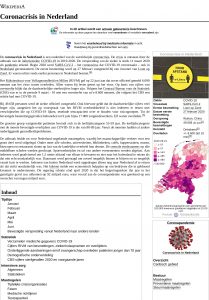
Wiki – Coronacrisis_in_Nederland – 20200628001 – Wiki – Coronacrisis_in_Nederland – 20200628001
(*) Betekent/denotes: In bezit.
(*1) Betekent/denotes: In bezit als PDF/Kopie.
